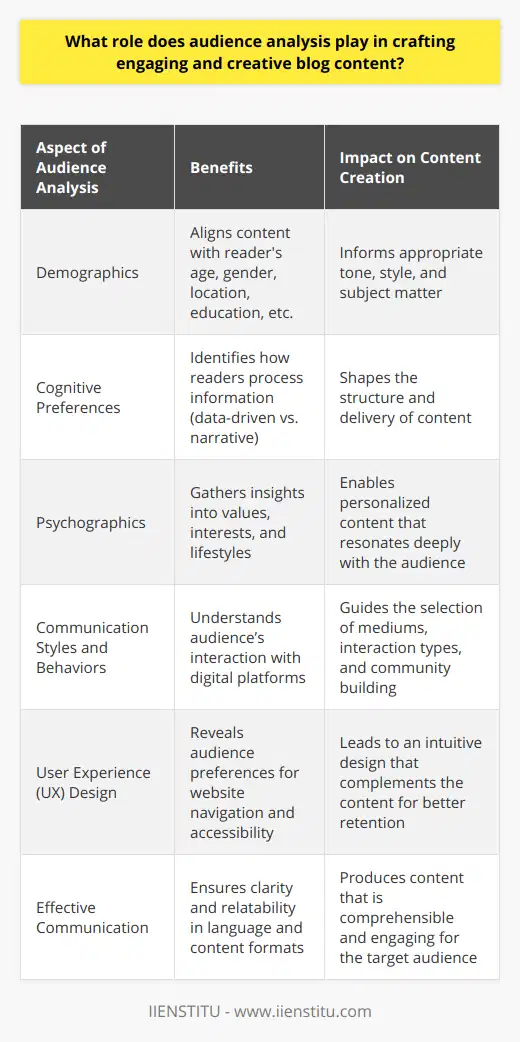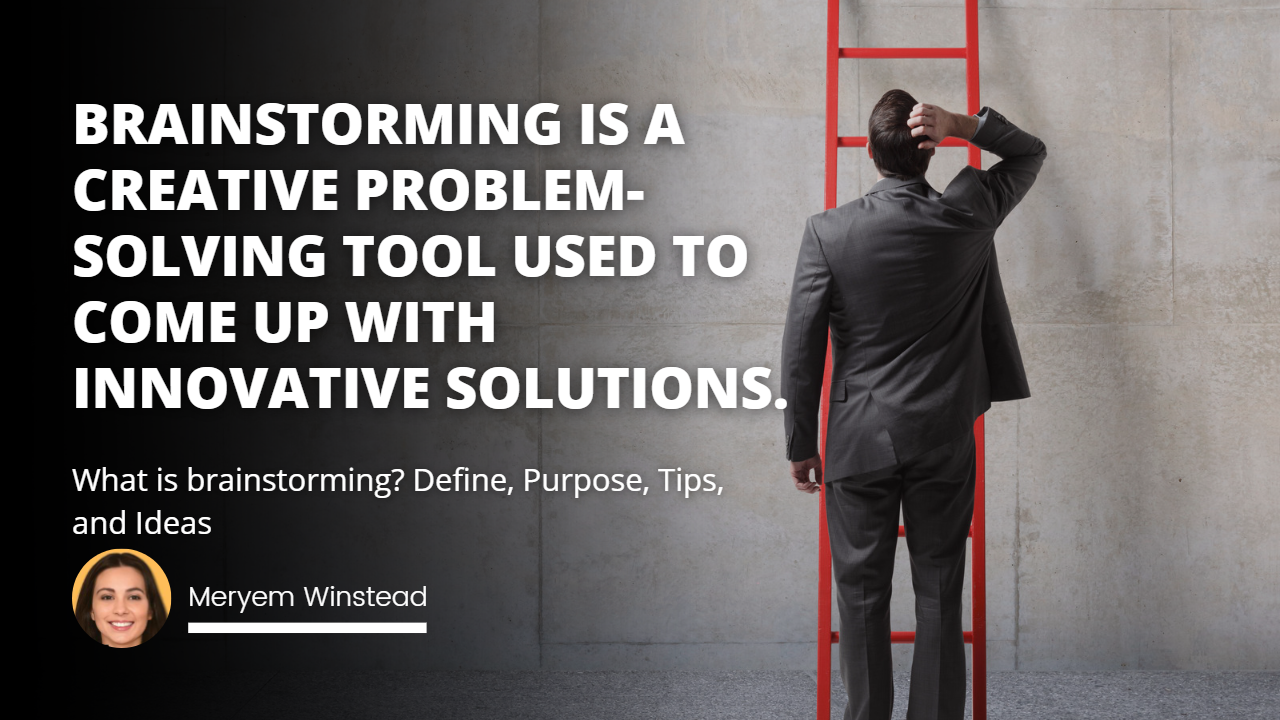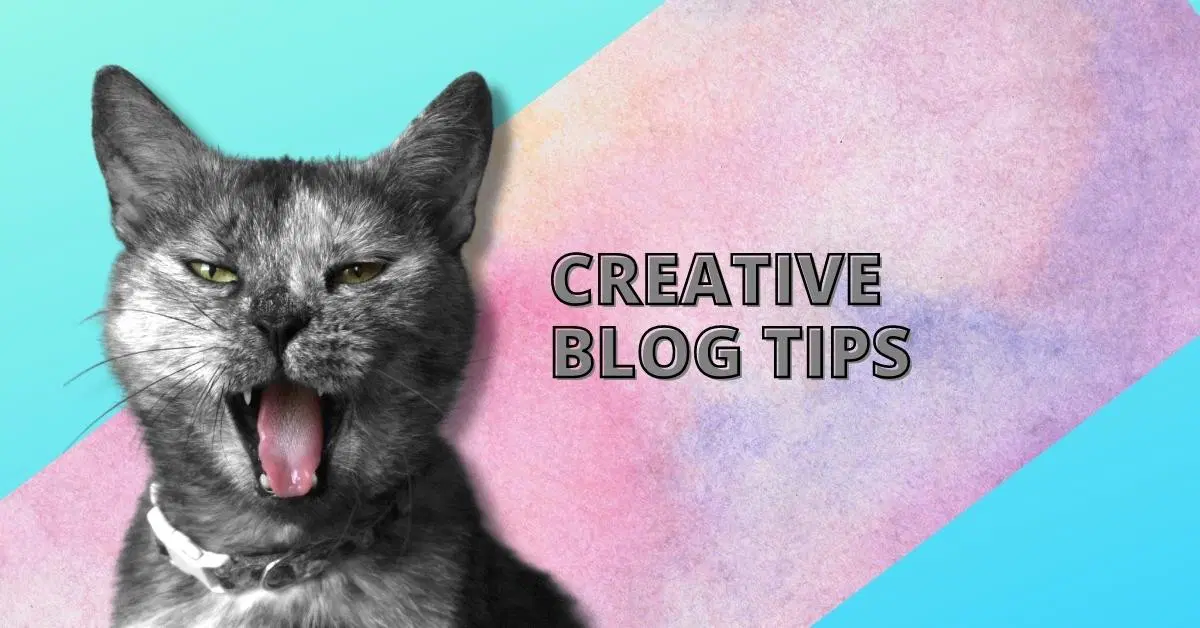
Creativity is the new value of our time. It's how we make sense, find meaning in an overwhelming world that seems more daunting by the day. But creativity can only take you so far without hard work on your end too!
The modern workplace was never designed to be where people would need to rely heavily upon their own skillset. After all, some machines do much faster and better than any human could ever hope at producing good quality content. But in the internet age, where anyone can be a publisher, creativity has become more critical than ever before.
To be successful in the online world, you need to create content that is both original and engaging. And this takes hard work as well as creativity. You can't just sit back and wait for the muse to strike - you have to be willing to put in the hours necessary to produce high-quality content.
So don't be discouraged if you're not a naturally creative person. With a bit of hard work, you will be surprised at how much your creative output can improve.
What Are The Creative Blog Post Ideas?
You might not be able to come up with something great on the spot, but there is hope! So here's how you can get started brainstorming for your next posts.
Here are some tips for coming up with great creative blog post ideas:
The first thing you should do when beginning to brainstorm for blog post ideas, the first thing you should do is to get your mind prepared.
OK, I've got nothing here... what else could I possibly write about? Well, let's take a look at the list of topics down below and see which one might spark some inspiration! There are many options, and you're bound to find something that catches your attention.
Some of the ideas might still sound a little dry, but at least it's somewhere to start. Once you've got your mind prepared and you know what kind of topics you want to write about, there are some specific ways you can go about brainstorming for creative blog post ideas:
Start with a random word and see how the idea takes you. The words below will do just fine. Think of something related to the particular topic and start from there!
For example; Junk food
Create your own list based on any kind of topic in mind, even if it's not food-related!
Write about a time you went crazy with junk food and what happened as a result.
Make a top ten list of your favorite junk foods.
Create a recipe for a healthier version of one of your favorite junk foods.
Write about the dangers of overeating junk food.
Write about your favorite junk food memories.
If you don't have a blog, write about the impact of certain kinds of food on your moods and how they affect you.
And so on! You can come up with many creative ideas for blog posts by thinking about junk food differently.
Creative blog post ideas for the holidays:
Write about how your family celebrates the holidays, what traditions you have, etc.
Do a holiday baking tutorial for one of your favorite recipes.
Create a gift guide for people who have everything.
If you don't celebrate certain holidays, write about something you like to do during this time of year.
Research or interview people who live in different parts of the world and find out what holidays they celebrate. ...and so on!
Other examples about creative blog post ideas:
Research or interview people who live in different parts of the world and find out how they celebrate the New Year.
Write about your favorite New Year's Resolutions and how you plan to stick to them.
Write about how to make the most out of your Valentine's Day this year.
How To Make Your Own Blog Posts More Creative?
1. Be personal
One of the easiest ways to make your blog posts more creative is by being more personal with your writing. Instead of sticking to a strict topic or just providing information, try sharing some of your own thoughts and experiences on the matter at hand. This will help readers connect with you on
2. Be interesting
No one wants to read a blog post that’s just the author’s opinionated ramblings. To make your posts more interesting, try adding in some facts, statistics, or other forms of evidence to back up your points. This will help readers take you seriously and make your posts more credible.
3. Be unique
To stand out from the rest of the blogging world, you need to be creative and offer unique content to your blog. This could be anything from a new perspective on a familiar topic to a completely different topic altogether. As long as it’s exciting and engaging, readers will be drawn to your blog.
4. Be visual
With the rise of social media, visuals have become an increasingly important aspect of online content. Infographics, photos, and videos can help break up long blocks of text and make your posts more visually appealing. Not only that, but they can also help you communicate your ideas more effectively.
Do you have any tips on making your blog posts more creative? Share them in the comments below! Before the end, I recommend the to you blogging course. You can learn how creative blogging writes and more about unique and enjoyable content. IIENSTITU is the best platform ever you heard about the blogging course. You can join a blogging course for free! Learn new things through free online courses with certifications.
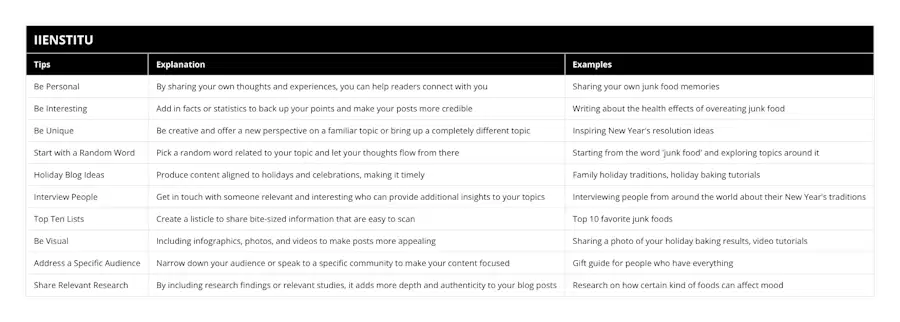
Frequently Asked Questions
How do you write a creative blog post?
Understanding the Concept of a Creative Blog Post
To write a creative blog post, it is essential to first have a clear understanding of the topic and the target audience. The blog content should be engaging, original, and offer valuable information to the readers.
Brainstorming Ideas
A crucial step to the development of a creative blog post is brainstorming. This involves listing down ideas, research, and possible angles from which the topic can be presented. It may involve creating visual or textual outlines, which helps in organizing thoughts and ensuring coherent content.
Appropriate Structure and Formatting
Creative blog posts require appropriate structure and formatting that makes it easy for the reader to follow. The use of headings, lists, and paragraphs helps to break the content into smaller sections, making it more digestible. It is also essential to ensure proper grammar, punctuation, and sentence construction.
Incorporating Visual Elements
Visual elements such as images, infographics, or videos, when used strategically, can enhance the appeal of a creative blog post. These elements not only attract readers but also aid in conveying the message more effectively.
Personal Touch and Storytelling
Including personal experiences and anecdotes adds a unique touch and makes the blog post more relatable to the readers. Storytelling can be an effective tool to present information in a more engaging and memorable manner.
Effective Use of Keywords
To ensure search engine visibility, it is crucial to incorporate keywords in the blog post effectively. Conducting keyword research and seamlessly integrating them into the content without compromising readability is vital for both search engines and readers.
Use of Call-to-action
The purpose of a creative blog post is not only to inform but also to initiate further engagement from the readers. Including a call-to-action at the end of the post, whether it be sharing the blog, leaving a comment, or subscribing to the blog, can encourage reader interaction.
In conclusion, crafting a creative blog post involves a mix of research, original ideas, appropriate structure, relevant visuals, personal experiences, and effective keyword integration. Most importantly, it requires memorable and engaging storytelling that resonates with readers and drives them to act.
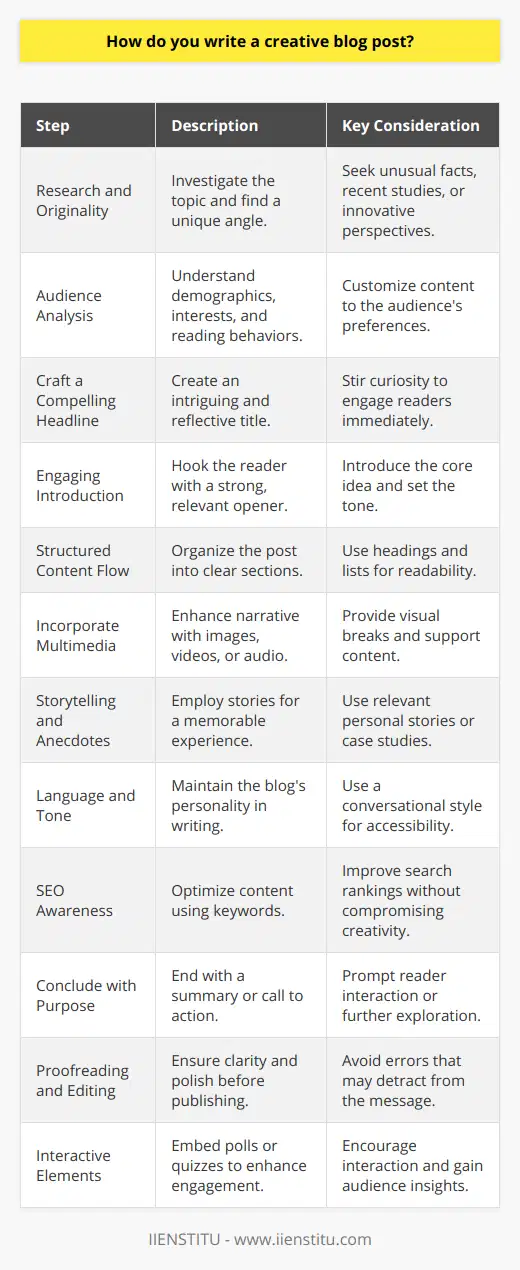
What is a creative blog?
Understanding Creative Blogs
A creative blog, distinct from other types of blogs, usually focuses on the presentation of original content in various artistic forms, such as prose, poetry, illustrations, and photography. Bloggers who maintain creative blogs often seek to express their personal perspectives and emotions through the arts, using the digital medium as a platform to share their work with others. Unique creativity is the lifeblood of such blogs, as they center around the author's imaginative powers and artistic skillset to engage readers and foster connections with like-minded individuals.
Types of Content in Creative Blogs
Content featured in creative blogs can take on multiple forms, ranging from text-based pieces like short stories and poetry, to visual arts that encompass illustrations, paintings, and photography. Some creative blogs may also include multimedia formats like videos or podcasts, providing auditory experiences to their readers. Through these diverse formats, creative bloggers strive to evoke emotion or provoke thought, shaping their content to communicate the desired message effectively.
Role of Aesthetics and Design
To further enhance the creative impact of their blogs, many authors pay close attention to the aesthetic and design aspects inherent to their digital space. Consequently, the interface and layout of creative blogs tend to be visually appealing, showcasing a personalized artistic style. Typically, these design elements complement the content and serve to establish the overall mood or atmosphere of the blog. In this way, creative bloggers enhance their work's impact by delivering a memorable and holistic reading or viewing experience.
Building Communities and Network
Creative blogs also play a crucial role in fostering connections among individuals who appreciate the arts in varied forms. By sharing their work, these bloggers can attract readers who resonate with their creative expressions, encouraging interaction through comments, emails, or social media engagement. In this way, creative blogs cultivate a sense of community, providing a space for readers to share perspectives, ideas, and encouragement. This network building aspect ultimately supports the growth and evolution of both the author's work and those who choose to engage with it.
In summary, a creative blog is an online space where authors share original artistic content, utilizing a variety of formats to express emotions and ideas, while also emphasizing aesthetics and design to enhance the overall experience. These blogs engender an interactive community built around the appreciation of the arts, fostering connections and collaboration among like-minded individuals.

How do I find unique blog topics?
**Identifying Interests and Passions**
To find unique blog topics, begin by reflecting on your interests and passions. Determine what subjects you are truly enthusiastic about, as this will help you create engaging and original content. Understanding your field of expertise is essential to stand out in the saturated world of blogging.
**Research Trends and Online Conversations**
Next, conduct thorough research of trends and online conversations within your chosen subject area. Utilize platforms such as social media, news websites, and other blogs to explore popular topics and identify gaps in the existing discourse. Be attentive to unanswered questions and under-discussed issues that may spark new ideas for your own blog.
**Analyze Competitors and Influencers**
Take note of your competitors and industry influencers who may have already established credibility within your niche. Analyze their strengths, weaknesses, and unique selling points to determine how you can differentiate your blog. By understanding the competition, you can carve out your unique positioning and offer novel insights on your blog.
**Consider Your Target Audience**
Keep in mind the preferences and needs of your target audience when generating blog topics. Study their characteristics, demographics, and online behavior to better understand their preferences and tailor your content accordingly. Addressing their specific concerns and interests will establish you as a trusted and valuable source of information.
**Stay Updated and Attend Events**
Finally, remain current with the latest news, events, and developments in your field. Consume relevant books, articles, and podcasts continually. Attending conferences, seminars, and networking events can expose you to new ideas and topics that your blog can explore, allowing you to maintain a fresh and engaging content roster.
By following these strategies and remaining genuine in your content creation, you can effectively find unique and intriguing blog topics that will intrigue and captivate your target audience.
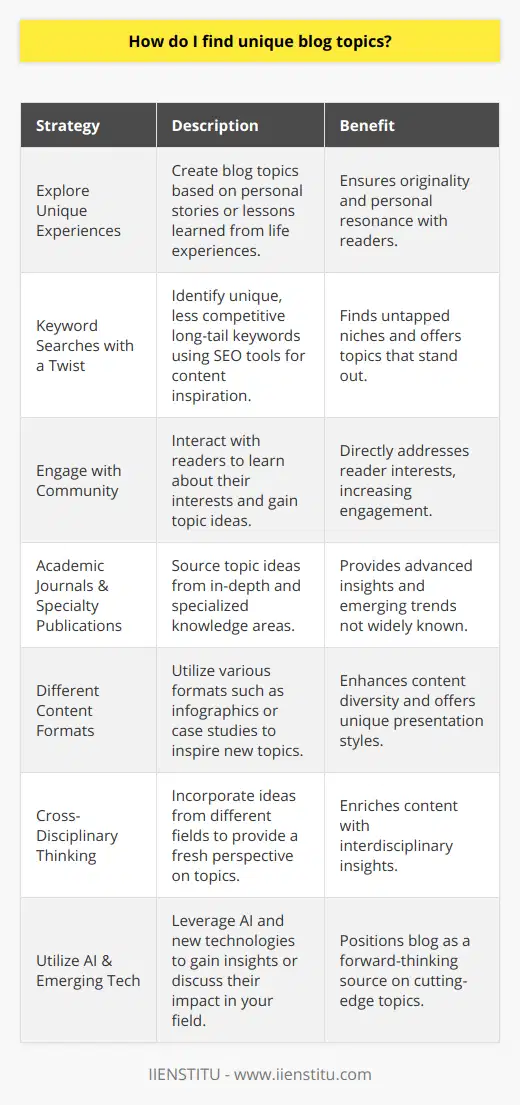
What are the 4 main sections of a blog theme?
Introduction
A blog theme is a fundamental aspect of web design, as it serves as the foundation for the overall appearance and organization of a blog. The four main sections of a blog theme include the header, content area, sidebar, and footer. These components contribute to the structure, visual appeal, and functionality of a blog. Understanding the significance of each section can help improve the design and user experience of a blog.
Header
The header is the topmost section of a blog, housing elements such as the navigation menu, blog logo, and tagline. This area plays a crucial role in establishing the blog's brand identity and providing easy access to key pages. Since visitors often form an impression in a matter of seconds, an attractive and informative header can increase the chance of engaging users and retaining their interest.
Content Area
The content area is the primary focus of a blog, as it displays the articles, images, and multimedia that are at the heart of the user experience. This section must be designed in a manner that promotes readability, legibility, and accessibility. The layout and typography should be chosen carefully to enhance comprehension, and the use of white space can serve to guide the eye and make the content more appealing. Ultimately, the content area should prioritize clarity and a positive reading experience.
Sidebar
The sidebar is a supplementary section that typically appears adjacent to the content area, providing additional resources and features to support the main content. Common elements found in sidebars include social media links, search functions, categories, and archives. These components help users navigate the blog and explore related content, encouraging deeper engagement and traffic across the site. A well-designed sidebar can greatly enhance the overall user experience and increase the blog's effectiveness in meeting its objectives.
Footer
Finally, the footer is located at the bottom of the blog and houses elements such as contact information, copyright notices, and links to terms and conditions. This section serves as a utility space, offering important information and resources that may not fit elsewhere in the design. The footer can also be used for branding purposes, displaying logos or taglines that reinforce the blog's identity. Although it may not be the most visible aspect of the blog, a well-designed footer contributes to a professional and cohesive appearance.
In conclusion, the four main sections of a blog theme—header, content area, sidebar, and footer—comprise the foundational structure of a blog's design. Each section serves an essential role in creating an engaging and user-friendly experience. With a strong understanding of these components, the design of a blog can be optimized for both visual appeal and functionality.
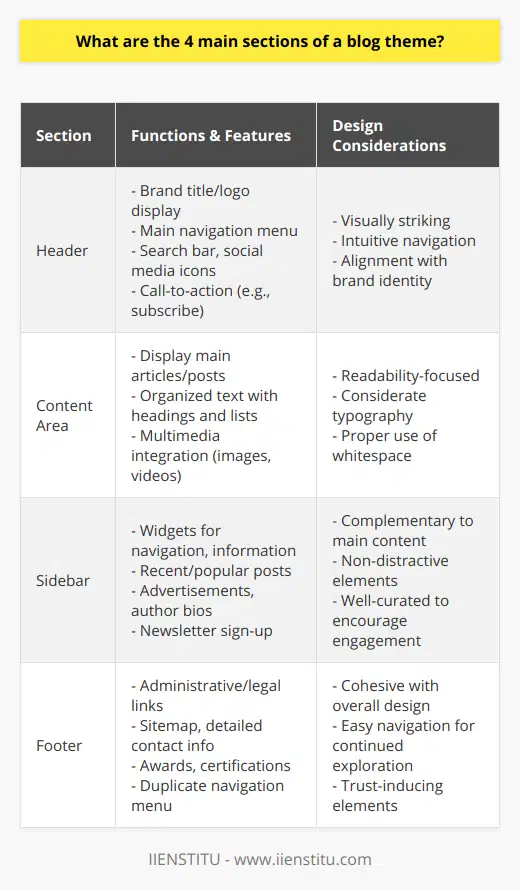
How can I effectively structure a creative blog post to engage readers?
Understanding the Blog Post Structure
To effectively structure a creative blog post that engages readers, one should implement several strategies. These include utilizing clear and concise language, providing visual aids, organizing content into sections, and employing a storytelling approach to captivate the audience's attention.
Utilizing Clear and Concise Language
The use of clear and concise language is vital in ensuring the blog post is accessible and comprehensible. By employing simple sentence structures and avoiding jargon or complicated terminology, readers are more likely to sustain their interest and remain engaged throughout the post.
Providing Visual Aids
Visual aids can enhance a reader's understanding of the content and maintain their interest by visually breaking up textual monotony. Adding images, videos, or infographics to a creative blog post can help to illustrate essential points and create an appealing layout that encourages further reading.
Organizing Content into Sections
Organizing a blog post's content into distinct sections with subheadings enhances readability and simplifies the reading process for the audience. This organization allows readers to quickly identify the topics discussed, enabling them to navigate the blog post with ease and pinpoint the information they find most relevant.
Utilizing a Storytelling Approach
Implementing a storytelling approach in a blog post can create a strong emotional connection with readers, contribute to an engaging narrative, and enhance the overall reading experience. By sharing relatable anecdotes, personal experiences, or connecting themes to real-life events, readers are more likely to remain engaged and find the content compelling.
In conclusion, to effectively structure a creative blog post to engage readers, one must employ clear and concise language, incorporate visual aids, organize content with subheadings, and use a storytelling approach. By following these guidelines, a creative blog post will effectively captivate the reader's interest and leave a lasting impression, contributing to the overall success and impact of the blog post.
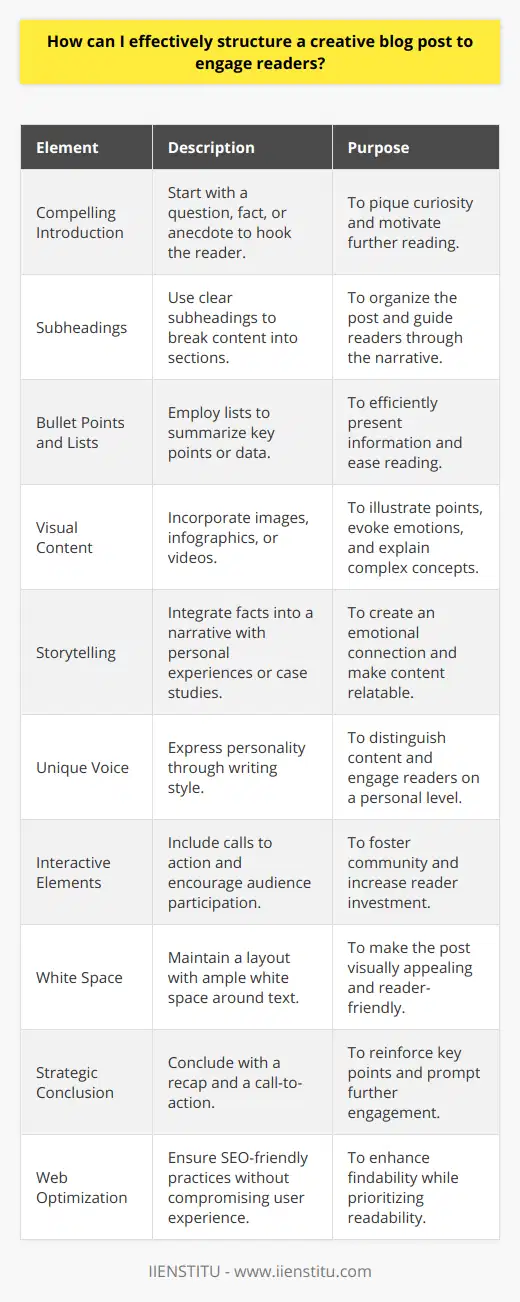
What techniques can be employed to generate innovative ideas for blog content?
**Brainstorming Techniques**
One of the techniques to generate innovative blog post ideas is brainstorming, which involves creating a long list of potential topics or themes. By jotting down several ideas, a blogger can explore possibilities and creative angles that otherwise might have been overlooked.
**Content Curation and Research**
Curating content from reputable sources or performing adequate research within the blog's niche can also lead to generating unique ideas. Studying current trends or issues, examining personal experiences or interests, and investigating the target audience's preferred topics can provide inspiration.
**Mind Mapping**
Mind mapping is another effective technique, where a blogger visually organizes information and explores potential concepts. By drawing relationships between ideas, a blogger can identify connections or branches that give birth to innovative post themes.
**Question and Answer Approach**
Additionally, a blogger can use a question and answer approach to generate ideas. By addressing queries from readers or anticipating the audience's concerns, writers can provide helpful solutions to problems, resulting in valuable and innovative content.
**Collaboration**
Collaboration with fellow bloggers or seeking input from subject matter experts can introduce fresh perspectives and new ideas for blog posts. This cooperation can foster a stimulating environment for creative thinking and generate innovative content.
**Social Media and Online Communities**
Lastly, social media networks and online communities can serve as fertile ground for gathering innovative ideas. By engaging in relevant discussions, monitoring popular discussions, and observing what resonates with the target audience, a blogger can generate intriguing and appealing post ideas.
In conclusion, employing techniques like brainstorming, content curation, mind mapping, question and answer approach, collaboration, and leveraging social media can help generate innovative ideas for blog content. These methods enhance a blogger's creative process and contribute to the production of high-quality, engaging posts that resonate with readers.
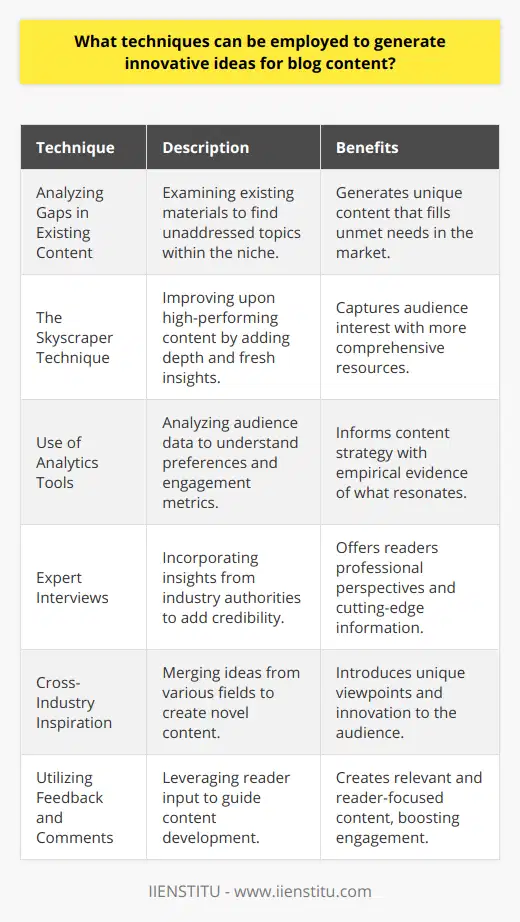
What are the key elements to consider when developing a creative blog post?
Elements of a Creative Blog Post
Content Planning and Ideation
One of the key elements to consider when developing a creative blog post is the planning and brainstorming of content ideas. It is critical to identify a specific topic that remains relevant and interesting to the target audience. Additionally, blogs should provide value, whether through entertainment, education, or inspiration.
An Engaging Title
Creating an attention-grabbing title is crucial for attracting readers to a blog post. The headline should accurately represent the content while also piquing interest and curiosity. Incorporating relevant keywords is essential for search engine optimization and improving online visibility.
Audience and Voice
Considering the target audience is an essential aspect when developing a creative blog post. A thorough understanding of the reader demographic will help tailor the tone, language, and formality of the content. Additionally, maintaining a consistent voice throughout blog posts establishes the blogger's identity and builds a connection with readers.
Visual Appeal
Visual elements, such as images, infographics, and videos, enhance the overall aesthetic of a blog post. These visuals can help break up the text, making it more digestible for readers. Furthermore, images and videos can offer supplemental information to complement the written content.
Organized Structure
An organized structure improves the readability of a blog post. Employing subheadings, bullet points, and shorter paragraphs can help guide the reader through the content. Formatting techniques, such as bolding or italicizing important points, can also assist in emphasizing key ideas within the text.
Internal and External Links
Incorporating both internal and external links throughout a blog post is important for credibility and improving search engine rankings. Internal links direct readers to other relevant content on the blog, promoting exploration. Simultaneously, external links support claims made in the content and provide additional resources for readers.
Conclusion and Call-to-Action
Concluding a creative blog post with a summary and incorporating a call-to-action encourages readers to engage further. This call-to-action may prompt readers to comment, share the content, or explore other blog posts. Engaging readers fosters a sense of community and promotes the blog's overall growth.
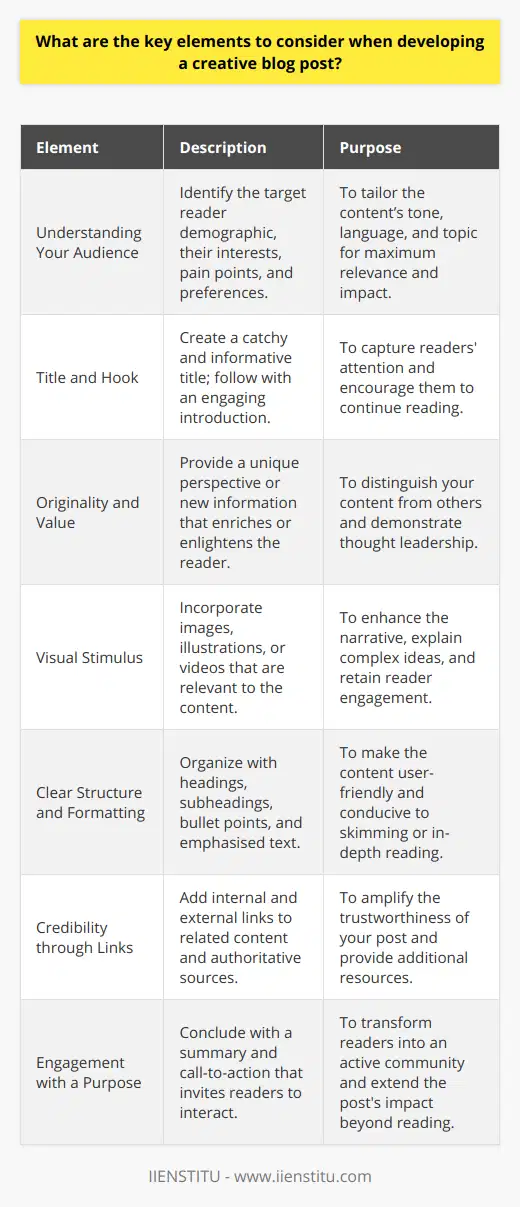
How can one maintain a consistent creative voice in blog writing?
Understanding Your Creative Voice
To maintain a consistent creative voice in blog writing, one must first understand their unique style and voice. This involves examining the tone, diction, and personality conveyed through their writing. Identifying specific attributes that make the author's voice distinct is crucial to maintaining consistency in their blog entries.
Creating a Writing Guide
Developing a writing guide consisting of the attributes identified in the previous step can serve as a reference point for future blog posts. This guide can include preferred language, vocabulary, tone, and style, ensuring that the author's voice remains a constant throughout each blog entry. Additionally, this guide can evolve over time as the writer gains experience and further refines their creative voice.
Practicing Consistency in Tone and Style
Writing consistently bolsters the development of an individual's unique creative voice. To achieve this, a blogger must create content regularly and remain mindful of their writing guide. This practice allows for the identification and mitigation of any inconsistencies that may arise in various posts, enabling the development of a more harmonious writing voice.
Balancing Creativity and Consistency
Maintaining consistency does not equate to sacrificing creativity. Bloggers must strike a balance between adhering to their established creative voice and exploring new ideas or styles. Allowing for flexibility within a certain range can result in an engaging and dynamic blog while still retaining a recognizable and consistent voice.
Embracing Feedback
Receiving feedback from readers is invaluable for maintaining a consistent creative voice. Constructive criticism from the audience can highlight discrepancies in the author's writing style or tone, which may be corrected or incorporated as needed. This interaction allows for continuous improvement and consistency in the blogger's creative voice.
In conclusion, understanding one's creative voice, creating a writing guide, practicing consistency, balancing creativity, and embracing feedback are essential steps to maintaining a consistent creative voice in blog writing. By adhering to these strategies, bloggers can develop a coherent and engaging persona that resonates with their audience.
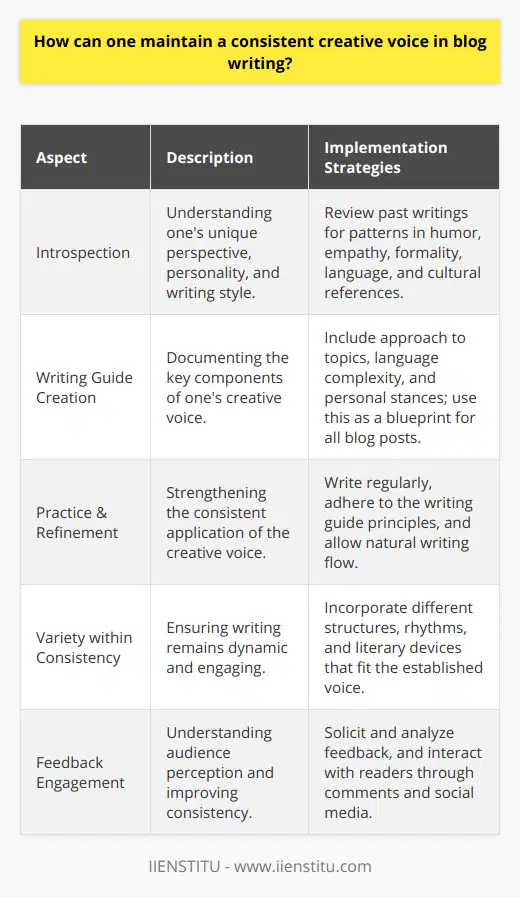
In what ways can one optimize blog post titles and headings for both reader engagement and search engine optimization?
Optimizing Blog Post Titles
One key aspect of maximizing reader engagement and search engine optimization is crafting compelling and relevant blog post titles. In order to achieve this, applying various techniques can significantly improve the effectiveness and impact of the titles.
Incorporating Keywords
Blog post titles should include specific keywords related to the content. These keywords enable search engines to easily identify and index the content, thus improving the blog's search ranking. Additionally, incorporating keywords ensures that the post is relevant to the target audience.
Balancing SEO and Engagement
It is essential to maintain a delicate balance between optimizing titles for search engines and engaging readers. Bloggers should primarily emphasize crafting titles that intrigue and pique the interest of their audience, while also ensuring appropriate keyword usage to appease search engines.
Utilizing Numbers and Emotional Triggers
Incorporating numbers and emotional triggers in titles can significantly increase engagement. Studies have shown that numbered list titles often lead to higher click-through rates, as they convey precise, easily digestible information. Emotional triggers, such as adjectives that evoke strong feelings, can further attract readers.
Formatting Titles for Readability
To improve the readability of blog post titles, writers should adhere to proper title case format, capitalize important keywords, and avoid excessive punctuation. Additionally, using consistent formatting across the blog will ensure a professional-looking site that is easy for readers to navigate.
Considering Length and Structure
For optimal engagement and search engine optimization, blog post titles should be clear, concise, and no longer than 60 characters. This length enables search engines to display complete titles without truncation, while also ensuring skimming readers can immediately grasp the content's main focus.
In conclusion, optimizing blog post titles and headings significantly contributes to the success of a blog. Considering elements such as keywords, balance, numbers, emotional triggers, formatting, and length will ultimately lead to increased reader engagement and search engine visibility.
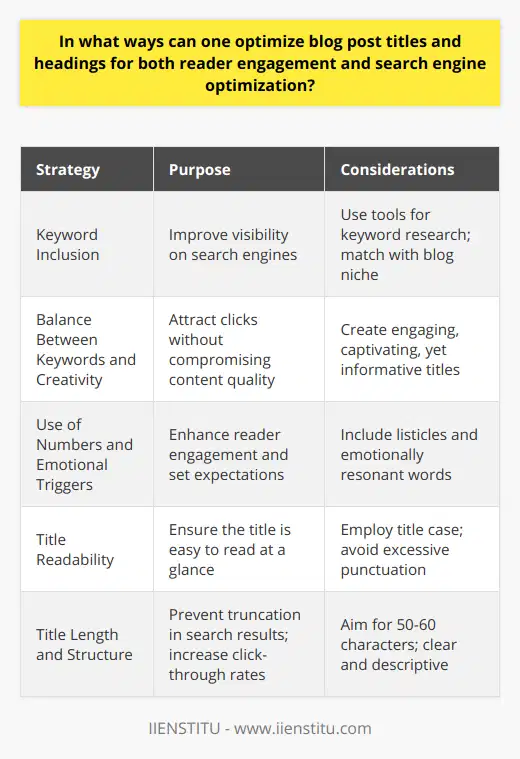
What are some effective strategies for identifying and capitalizing on current blog trends?
Understanding Current Trends
A primary strategy in identifying current blog trends is to regularly monitor leading blogs, social media platforms, and publishing platforms. Platforms like Medium, Reddit, and Twitter have sections for trending content, which often mirror the blogosphere's current interests.
Keyword Analysis
Similarly, keyword analysis tools such as Google Trends, Ahrefs, or SEMrush can provide insight into the topics that are currently popular worldwide. These tools allow the user to identify keywords that have gained or lost popularity over time, providing an indication of shifting trends.
Leveraging Search Engine Optimisation Tools
Search Engine Optimization (SEO) tools also offer monitoring services that can help identify trending blog topics. Tools like Moz and SEMRush provide alerts on trending keywords, competitor analysis, and SEO ranking changes, helping bloggers stay updated on trends.
Capitalizing on Trends
Once a trend has been identified, it's vital to capitalize on it appropriately. First, bloggers need to integrate trend-related keywords into their content in a way that doesn't compromise their message. Bloggers should also consider the trend's relevance to their current brand or message to assure post consistency.
Interactive Content
Another strategy is creating interactive content related to the trend. This could include online polls, quizzes, or infographics that increase user engagement and make the post more likely to be shared.
Timing and Frequency
Finally, factors including timing of the blog post and frequency of updates can significantly impact its success. Regularly updating blog content based on identified trends can help bloggers connect with their audience and improve visibility. Blogs should be updated while the trend is at its peak to take advantage of its popularity.
By understanding and implementing these strategies, bloggers can effectively identify and capitalize on current trends to boost their visibility and reader engagement.
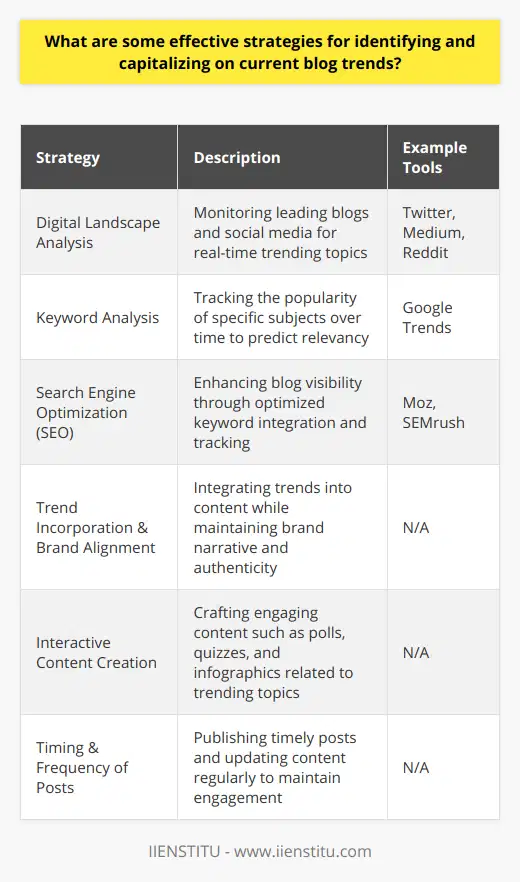
How can the use of multimedia elements enhance the creativity and appeal of a blog post?
The Use of Multimedia Elements in Blogs
Multimedia elements can significantly improve the creativity and appeal of a blog post. Such elements, including images, videos, audio clips, and interactive content, add an extra dimension to the text. They contribute by offering varied ways to consume and understand the information provided.
Enhancing Visual Appeal
Images and videos provide a visual representation of the information in the blog post. These elements improve the aesthetics of the blog, making it more enticing for readers. A well-chosen image or a compelling video clip can evoke emotions, stimulate curiosity, and help in retaining the attention of the audience.
Encouraging User Engagement
Interactive content, such as quizzes or infographics, can encourage user engagement. They require active participation from the reader, enhancing their investment in the content. This active engagement can imply better understanding and information retention.
Offering Variety in Content Consumption
Multimedia also offer readers different ways to access the same information. For instance, a video or an audio clip may present information to those who prefer listening over reading. Offering variety in content consumption caters to different reader preferences, thereby broadening potential audience appeal.
In conclusion, the use of multimedia elements in a blog post not only enhances its visual appeal but also encourages reader engagement. It offers different ways of consuming information, catering to varied reader preferences. Ultimately, multimedia can make a blog post more creative, engaging, and appealing.
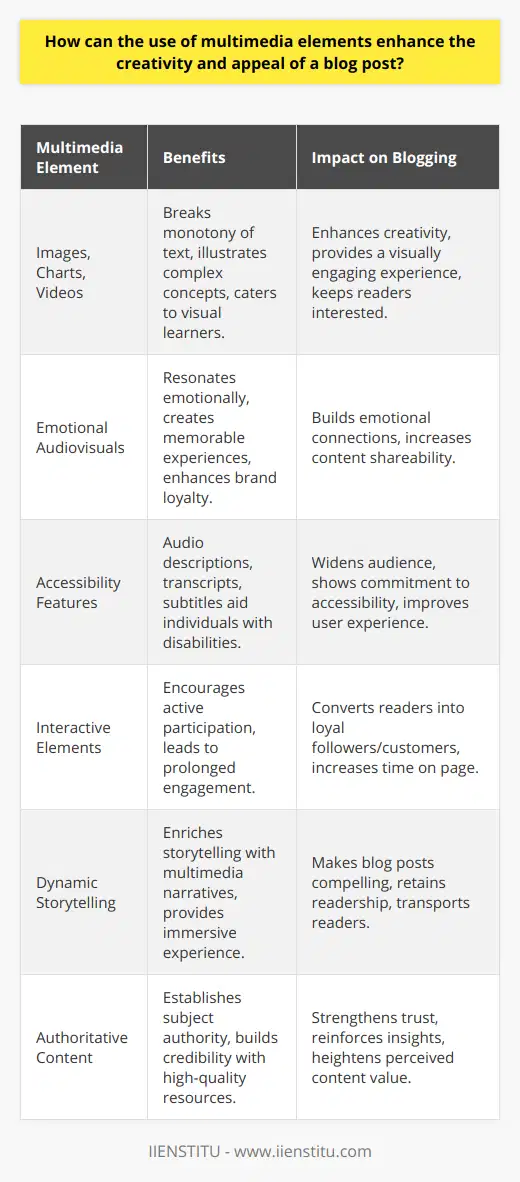
What role does audience analysis play in crafting engaging and creative blog content?
Understanding the Audience
Audience analysis plays a pivotal role in the creation of engaging and creative blog content. By understanding who the audience is, a content creator can tailor their message to suit the audience's needs, preferences, and interests.
Audience Demographics
Demographic information like age, gender, occupation, education level and ethnicity can give insights into the audience's general preferences. This data is valuable in choosing an appropriate style, tone, and language for the blog content.
Cognitive and Emotional Factors
Individual cognitive and emotional responses play a role in audience engagement. This includes learning styles, attention spans, problem-solving abilities, and emotional triggers. Knowing these will help in presenting information in an engaging manner, sparking interest and evoking emotion.
Psychographics and Lifestyles
Understanding lifestyle and psychographic factors such as attitudes, beliefs, values, habits, and lifestyle elements allow the content creator to tailor the blog content. This can increase its relevance, appeal, and impact.
Online Behavior
Also, researching the audience's online behaviour like preferred social media platforms, habits, and interaction styles will guide the content creator in the selection of topics and presentation styles.
The User Experience
Audience analysis directly shapes the user experience. Through this, the content creator can design the blog's website layout, navigation system, and other elements to suit the audience's preferences, improving navigation and interaction.
Effective Communication
In conclusion, audience analysis is a strategic tool employed by bloggers to craft highly engaging and creative content. Audience analysis ensures effective communication by addressing the audience’s distinctive traits, preferences, and online behaviors. Understanding the audience helps to create content that genuinely appeals to them, guaranteeing heightened engagement and a potentially larger audience base.
